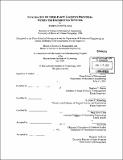| dc.contributor.advisor | Stephen C. Graves and Lionel C. Kimerling. | en_US |
| dc.contributor.author | Vlasak, Andrea Lynn, 1974- | en_US |
| dc.contributor.other | Leaders for Manufacturing Program. | en_US |
| dc.date.accessioned | 2009-02-17T17:25:04Z | |
| dc.date.available | 2009-02-17T17:25:04Z | |
| dc.date.copyright | 2001 | en_US |
| dc.date.issued | 2001 | en_US |
| dc.identifier.uri | http://hdl.handle.net/1721.1/44606 | |
| dc.description | Thesis (S.M.)--Massachusetts Institute of Technology, Dept. of Mechanical Engineering; and, (M.B.A.)--Massachusetts Institute of Technology, Sloan School of Management; in conjunction with the Leaders for Manufacturing Program at MIT, 2001. | en_US |
| dc.description | Includes bibliographical references (p. 65-68). | en_US |
| dc.description.abstract | In its attempt to sustain the growth expectations in an increasingly competitive market, Intel Corporation has invested in a number of new products and services, which differ significantly from its core semiconductor business. In 2000, Intel purchased 12 companies, amounting to an investment value of approximately 6 billion dollars. Associated with these various businesses ventures are new customers, new channels, different product attributes, uncertain demand profiles, and various service requirements, all of which have a direct impact on Intel's strategy for physical distribution. The existing logistics infrastructure is not equipped to optimally distribute the greater product mix and respond to the added complexities. The integration of third party logistics providers into its current distribution network may enhance Intel's ability to respond to the growing needs of the diversified product offerings. This thesis explores the decision to outsource logistics activities. It presents both the financial and non-financial, strategic and operational factors, which affect the decision. The decision framework presented is applied to the current business situation at Intel and an outsourcing strategy, which both addresses the current distribution challenges, and compliments the overall strategy of the corporation, is recommended. The description of the recommended distribution strategy is followed by a discussion of the complications associated with executing the strategy and guidelines for effective supplier management in a logistics context. The decision to outsource is just one of the decisions analyzed in the development of distribution strategies. Studying the strategies utilized by other organizations can enhance the competitiveness of a firm's logistics network. This paper also describes the methodology developed for exchanging logistics information with other companies, and based on the evidence from the specific study conducted by Intel's Planning and Logistics Group, discusses the critical success factors for future external studies. | en_US |
| dc.description.statementofresponsibility | by Andrea Lynn Vlasak. | en_US |
| dc.format.extent | 68 p. | en_US |
| dc.language.iso | eng | en_US |
| dc.publisher | Massachusetts Institute of Technology | en_US |
| dc.rights | M.I.T. theses are protected by
copyright. They may be viewed from this source for any purpose, but
reproduction or distribution in any format is prohibited without written
permission. See provided URL for inquiries about permission. | en_US |
| dc.rights.uri | http://dspace.mit.edu/handle/1721.1/7582 | en_US |
| dc.subject | Mechanical Engineering. | en_US |
| dc.subject | Sloan School of Management. | en_US |
| dc.subject | Leaders for Manufacturing Program. | en_US |
| dc.title | Integration of third party logistics providers within the distribution network | en_US |
| dc.type | Thesis | en_US |
| dc.description.degree | M.B.A. | en_US |
| dc.description.degree | S.M. | en_US |
| dc.contributor.department | Leaders for Manufacturing Program at MIT | en_US |
| dc.contributor.department | Massachusetts Institute of Technology. Department of Mechanical Engineering | |
| dc.contributor.department | Sloan School of Management | |
| dc.identifier.oclc | 49013507 | en_US |
